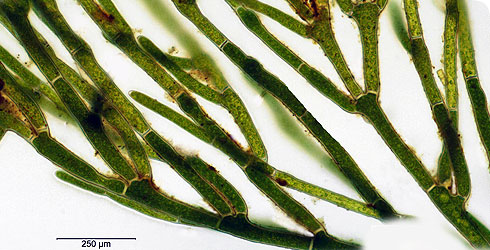Taxonomy
Aegagropila linnaei Kützing 1843 (= Cladophora aegagropila (Linnaeus) Rabenhorst).
Plants of dense and often dark green
- Irregularly branched filamentous, one to several branches arise from a cell in a subterminal position, sometimes in an irregular series or oppositely arranged
- Adventitious rhizoids arise from basal pole of cell and
- attach to or intertwine around the branches
- attach to the substratum, often coralloid in unattached forms
- Cells generally
- cylindrical, more often
- club-shaped towards base,
- lateral branches up to 200 µm wide and cells to
- 15 times longer than wide,
- very thick-walled (up to 20 µm thick)
- Apical cells 30–70 µm wide and up to 25 times longer than broad
Cells aggregate to form
- Coarse carpet or cushion-like growth more commonly occur in rivers compared to the loose-lying mats or ball-like growths that are frequently more abundant in lakes
- Lake balls are from 1.5 cm to about 30 cm in diameter and the larger ones are hollow since the central filaments decay as the ball increases in size.
- These balls have been known as ‘Cladophora balls’ but recent molecular studies have meant the transfer of Cladophora aegagropila back into the genus Aegagropila
